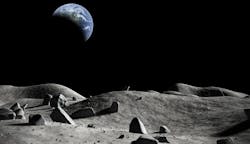Will the Future Run on Moon Power? India's Space Agency Bets Yes.
India’s space program wants to go where no nation has gone before -– to the south side of the moon. And once it gets there, it will study the potential for mining a source of waste-free nuclear energy that could be worth trillions of dollars.
The nation’s equivalent of NASA will launch a rover in October to explore virgin territory on the lunar surface and analyze crust samples for signs of water and helium-3. That isotope is limited on Earth yet so abundant on the moon that it theoretically could meet global energy demands for 250 years if harnessed.
“The countries which have the capacity to bring that source from the moon to Earth will dictate the process,’’ said K. Sivan, chairman of the Indian Space Research Organisation. “I don’t want to be just a part of them, I want to lead them.’’
The mission would solidify India’s place among the fleet of explorers racing to the moon, Mars and beyond for scientific, commercial or military gains. The governments of the U.S., China, India, Japan and Russia are competing with startups and billionaires Elon Musk, Jeff Bezos and Richard Branson to launch satellites, robotic landers, astronauts and tourists into the cosmos.
The rover landing is one step in an envisioned series for ISRO that includes putting a space station in orbit and, potentially, an Indian crew on the moon. The government has yet to set a timeframe.
“We are ready and waiting,’’ said Sivan, an aeronautics engineer who joined ISRO in 1982. “We’ve equipped ourselves to take on this particular program.’’
China is the only country to put a lander and rover on the moon this century with its Chang’e 3 mission in 2013. The nation plans to return later this year by sending a probe to the unexplored far side.
In the U.S., President Donald Trump signed a directive calling for astronauts to return to the moon, and NASA’s proposed $19 billion budget this fiscal year calls for launching a lunar orbiter by the early 2020s.
ISRO’s estimated budget is less than a 10th of that – about $1.7 billion – but accomplishing feats on the cheap has been a hallmark of the agency since the 1960s. The upcoming mission will cost about $125 million – or less than a quarter of Snap Inc. co-founder Evan Spiegel’s compensation last year, the highest for an executive of a publicly traded company, according to the Bloomberg Pay Index.
This won’t be India’s first moon mission. The Chandrayaan-1 craft, launched in October 2008, completed more than 3,400 orbits and ejected a probe that discovered molecules of water in the surface for the first time.
The upcoming launch of Chandrayaan-2 includes an orbiter, lander and a rectangular rover. The six-wheeled vehicle, powered by solar energy, will collect information for at least 14 days and cover an area with a 400-meter radius.
The rover will send images to the lander, and the lander will transmit those back to ISRO for analysis.
A primary objective, though, is to search for deposits of helium-3. Solar winds have bombarded the moon with immense quantities of helium-3 because it’s not protected by a magnetic field like Earth is.
The presence of helium-3 was confirmed in moon samples returned by the Apollo missions, and Apollo 17 astronaut Harrison Schmitt, a geologist who walked on the moon in December 1972, is an avid proponent of mining helium-3.
“It is thought that this isotope could provide safer nuclear energy in a fusion reactor, since it is not radioactive and would not produce dangerous waste products,’’ the European Space Agency said.
There are an estimated 1 million metric tons of helium-3 embedded in the moon, though only about a quarter of that realistically could be brought to Earth, said Gerald Kulcinski, director of the Fusion Technology Institute at the University of Wisconsin-Madison and a former member of the NASA Advisory Council.
That’s still enough to meet the world’s current energy demands for at least two, and possibly as many as five, centuries, Kulcinski said. He estimated helium-3’s value at about $5 billion a ton, meaning 250,000 tons would be worth in the trillions of dollars.
To be sure, there are numerous obstacles to overcome before the material can be used – including the logistics of collection and delivery back to Earth and building fusion power plants to convert the material into energy. Those costs would be stratospheric.
“If that can be cracked, India should be a part of that effort,’’ said Lydia Powell, who runs the Centre for Resources Management at the New Delhi-based Observer Research Foundation think tank. “If the cost makes sense, it will become a game-changer, no doubt about it.’’
Plus, it won’t be easy to mine the moon. Only the U.S. and Luxembourg have passed legislation allowing commercial entities to hold onto what they have mined from space, said David Todd, head of space content at Northampton, England-based Seradata Ltd. There isn’t any international treaty on the issue.
“Eventually, it will be like fishing in the sea in international waters,’’ Todd said. “While a nation-state cannot hold international waters, the fish become the property of its fishermen once fished.’’
India’s government is reacting to the influx of commercial firms in space by drafting legislation to regulate satellite launches, company registrations and liability, said GV Anand Bhushan, a Chennai-based partner at the Shardul Amarchand Mangaldas & Co. law firm. It doesn’t cover moon mining.
Yet the nation’s only spaceman isn’t fully on board with turning the moon into a place of business.
Rakesh Sharma, who spent almost eight days aboard a Russian spacecraft in 1984, said nations and private enterprises instead should work together to develop human colonies elsewhere as Earth runs out of resources and faces potential catastrophes such as asteroid strikes.
“You can’t go to the moon and draw boundaries,’’ Sharma said. “I want India to show that we’re capable of utilizing space technology for the good of people.’’
About the Author
Bloomberg
Licensed content from Bloomberg, copyright 2016.


